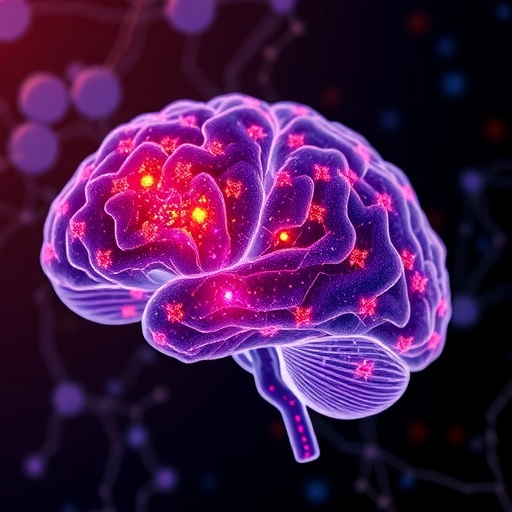In the relentless quest to combat the debilitating effects of Alzheimer’s disease (AD), a new frontier has emerged, spotlighting the enigmatic role of astrocytes—star-shaped glial cells that have long been overshadowed by neurons in neuroscience research. Recent findings from a pioneering study reveal that an intricate molecular switch within these supportive brain cells could hold the key to alleviating cognitive decline associated with AD. Central to this discovery is the transcription factor Sox9, whose overexpression in astrocytes ushers in a robust clearance of amyloid beta (Aβ) plaques, widely recognized as pathological hallmarks of Alzheimer’s disease.
Astrocytes, ubiquitous and essential for maintaining neuronal health and cerebral homeostasis, have traditionally been seen as mere background players. However, their dynamic involvement in neurodegenerative diseases is increasingly recognized, as accumulating evidence links astrocyte dysfunction to nearly every form of neurological disorder. The latest research thrusts astrocytes into the spotlight, revealing that by manipulating the activity of Sox9 within these cells, it is possible to significantly enhance their capacity to phagocytose, or engulf, toxic Aβ plaques in the aged hippocampus—a brain region crucial for memory and learning.
This transformative insight stems from detailed experiments conducted in mouse models genetically engineered to replicate key features of Alzheimer’s disease. These animal models allowed researchers to specifically elevate Sox9 expression in astrocytes and observe the subsequent effects on amyloid pathology and cognitive function. Remarkably, astrocytes with heightened Sox9 not only cleared existing Aβ deposits more efficiently, but also maintained synaptic integrity and preserved memory capabilities, demonstrating a promising therapeutic potential that transcends symptom management.
Delving into the molecular machinery underlying this phenomenon, the study identified that Sox9 exerts its beneficial effects primarily by upregulating MEGF10, a phagocytic receptor found on astrocytes. MEGF10 acts as a critical mediator for astrocytes to recognize, engulf, and degrade Aβ plaques, thereby mitigating their neurotoxic impact. The coordinated Sox9-MEGF10 signaling axis essentially equips astrocytes with enhanced neuroprotective properties, fundamentally altering the microenvironment of the diseased brain toward recovery rather than decline.
What is particularly striking is the context-specificity of Sox9’s role in the aging hippocampus and AD models. While the transcription factor is vital for astrocyte function across developmental stages, its upregulation in the context of neurodegeneration preferentially augments the cells’ capacity for clearance without triggering deleterious reactive gliosis, a common pitfall in previous glial-targeted therapeutic strategies. This nuanced modulation suggests a sophisticated regulatory mechanism that could be leveraged to design more precise interventions.
These findings bear profound implications for the development of astrocyte-based therapeutics in neurodegenerative disorders. Alzheimer’s has long been an intractable disease, with treatments largely focused on symptom palliation rather than altering disease progression. The Sox9-MEGF10 pathway presents a novel target that enhances innate clearance mechanisms within the brain, offering a strategy that not only addresses plaque burden but also preserves cognitive faculties, a feat rarely achieved in preclinical AD studies.
Moreover, the study’s demonstration of cognitive preservation underscores the functional relevance of modulating astrocyte activity. Behavioral assessments in the transgenic mice revealed that those with Sox9-overexpressing astrocytes performed significantly better in memory and learning tasks compared to controls, highlighting the translational promise of this approach in mitigating Alzheimer’s-related cognitive deficits.
At a broader level, this research redefines our understanding of glial biology in neurodegeneration. Astrocytes emerge not as passive responders but as active participants with a capacity for self-repair and neuronal support when harnessed appropriately. The ability to genetically or pharmacologically modulate transcription factors such as Sox9 in specific cell types opens up an expansive frontier for therapeutic innovation.
Nevertheless, significant challenges remain before Sox9-driven therapies can be realized in human patients. Translating glial manipulation from mice to humans demands rigorous validation to ensure safety and efficacy, given the complexity of human brain architecture and pathology. Furthermore, identifying vectors or compounds capable of selectively modulating Sox9 activity in astrocytes without off-target effects will be critical in the drug development pipeline.
This discovery also invites a reassessment of the amyloid cascade hypothesis that has dominated Alzheimer’s research for decades. While Aβ clearance remains a cornerstone, the role of astrocytes as active mediators expands the conceptual framework, emphasizing the importance of cellular context and intercellular communication in disease progression. This shift could inspire complementary therapeutic strategies that integrate neuronal and glial targets rather than focusing exclusively on amyloid removal.
In conclusion, the identification of the Sox9-MEGF10 signaling axis as a powerful regulator of astrocyte-mediated Aβ plaque clearance and cognitive preservation in Alzheimer’s disease models represents a watershed moment. As researchers continue to unravel the multifaceted roles of glial cells, these findings energize the field with a transformative vision: that harnessing the intrinsic reparative capabilities of astrocytes could pave the way for effective interventions against one of the most pressing neurological challenges of our time.
Future studies will undoubtedly probe deeper into the molecular intricacies of Sox9 regulation, its downstream effectors beyond MEGF10, and the interplay between astrocytes and other brain cells in neurodegeneration. Such insights will be indispensable for crafting holistic and durable therapies that restore brain health and function. For now, Sox9 stands as a beacon of hope, illuminating a promising path forward in the fight against Alzheimer’s disease.
Subject of Research:
Astrocyte biology and its role in Alzheimer’s disease pathology, focusing on the transcription factor Sox9 and its regulation of amyloid beta plaque clearance.
Article Title:
Astrocytic Sox9 overexpression in Alzheimer’s disease mouse models promotes Aβ plaque phagocytosis and preserves cognitive function.
Article References:
Choi, DJ., Murali, S., Kwon, W. et al. Astrocytic Sox9 overexpression in Alzheimer’s disease mouse models promotes Aβ plaque phagocytosis and preserves cognitive function. Nat Neurosci (2025). https://doi.org/10.1038/s41593-025-02115-w
Image Credits:
AI Generated




